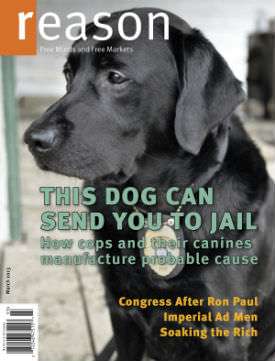How Even a 'Well-Trained Narcotics Detection Dog' Can Be Wrong 84 Percent of the Time

In my column today, I note that the Supreme Court, ruling for the first time that a drug-detecting dog's alert is by itself enough to justify a vehicle search, discounted the relevance of a dog's track record in the field, saying its performance in "controlled testing environments" is a better measure of reliability. One problem with that position is that such tests are often so poorly designed that it's impossible to say whether the dog is detecting drugs or reacting to its handler's cues. But even well-designed, double-blind tests grossly exaggerate a dog's ability to provide probable cause for searches in real-world conditions. As University of North Carolina at Chapel Hill law professor Richard E. Myers explains in a 2006 George Mason Law Review article, the basic problem is that drugs are always present in the testing situation but rarely present in people's cars. So even a dog that is very good at finding drugs in a "controlled testing environment" will generate a lot of false positives when sniffing randomly selected cars. In fact, Myers says, it is easy to imagine how even a well-trained drug-detecting dog could generate many more false positives than true positives.
Myers asks us to consider a dog who performs well in testing, failing to alert in the presence of drugs just 5 percent of the time. Furthermore, when this dog does alert, it is wrong just 10 percent of the time. The latter number sounds like a solid basis for probable cause—which, according to the Supreme Court, requires a "fair probability" that evidence of a crime will be discovered. But if this dog works at a checkpoint where cars are stopped at random, and if 2 percent of cars contain drugs, he will alert erroneously much more often than he alerts correctly:
With a pretty good dog, but a largely innocent population, a dog alert will signal drugs only about sixteen percent of the time. The reason is this: Because the officer is stopping mostly innocent people, one has to be more concerned about the false positive error (alerting when there are no drugs). Because there are more cars without drugs in them, the gross number of searches that result from the error rate will be higher than the gross number of searches that result from correct alerts. Overall, there will be many more searches of innocent people than there will be searches of guilty people.
You can click through to see Myers' math, which is based on a Bayesian probability formula. The results depend, of course, on exactly how good the dog is and what percentage of cars actually are carrying drugs. But assuming the percentage is low, the basic point remains: Even the "well-trained narcotics detection dog" of the Supreme Court's imagination will be wrong in this situation much more often than he is right. Given this reality, you can start to see how actual police dogs, who perhaps are not quite as well-trained as the Court assumes, could be wrong more than nine times out of 10 when they alert to randomly stopped cars, as they were at roadblocks set up by Florida state police in 1984.
If we move away from random selection and consider cars that are examined by dogs based on some sort of suspicion that falls short of probable cause, the percentage carrying drugs presumably is higher than the rate for the general population of motorists. That helps explain why a 2011 Chicago Tribune analysis of data from suburban police departments found that vehicle searches justified by a dog's alert discovered drugs or drug paraphernalia 44 percent of the time—still not great, but a lot better than the 4 percent managed by those dogs in Florida. Myers argues, contrary to what the Supreme Court ruled last week, that a dog's alert by itself should never count as probable cause. If the chance of finding drugs is something like 16 percent, as in Myers' example, that does not qualify as a "fair probability." Still, Myers says, a dog's alert may justify a search when combined with other evidence:
Simply because the alert alone should not constitute probable cause does not mean that the dog's alert is not a critical piece of evidence that can combine with other evidence to constitute probable cause. Suppose instead that the police officer deploys the dog upon a suspicion, based on other factors, that suggests the presence of narcotics. If the officer has a pretty good nose of his own for narcotics dealers, then other studies on hit rates of police officers conducting searches based on factors that otherwise have been held to constitute probable cause suggest he may have a thirty percent chance of being right. In that case, the prior probability that the car contains drugs will significantly increase the importance of the detector dog's alert. Under those conditions, the Bayesian calculation, with a thirty percent prior probability and a ninety percent accurate dog, would result in a seventy-nine percent chance that there are drugs in the car—clearly probable cause.
Myers concludes that "requiring reasonable suspicion coupled with the dog sniff—whether it is found before the sniff or after—is a simple and practical safeguard for ensuring the presence of probable cause before conducting the search." Unfortunately, the Supreme Court's decision in Florida v. Harris seems to rule out this sensible, reality-based approach.
For more on how police dogs function as "search warrants on leashes," see my cover story in the March issue of Reason.


Show Comments (18)